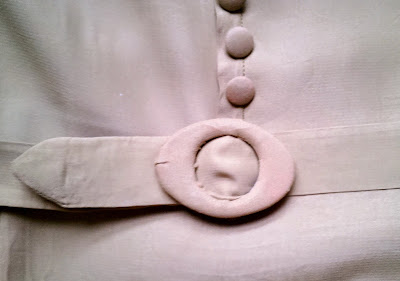The dress in this picture looks pretty neat and tidy.
Unfotunately that is not always the state you find them in, which was also the
case with this dress.
This was what the dress looked like just after I bought it.
In this blog post I will illustrate my way of tackling a few issues that I come across a lot but
that do not have to be real problems. Just a little love and care and time turn
a frump into a fabulous dress!
The first problem are the creases. Especially with rayon
these can be diffucult to iron out. When ironing to hot or using to much
pressure the fabric often starts to shine. Dampening the fabric with a
vaporizer helps a bit. For this dress however I opted for another solution (washing) because of a second problem: smelly armpits. Also not unknown to most
vintage buyers. A normal wash does generally not do the trick with 70 year old
BO. Neither does dry-cleaning, most of the time (and I also find it quite expensive). A cheap method I often use is a soak in white vinegar (the stuff you also use
for cooking).
I pour the pure vinegar in a deep plate. Vinegar does not
affect color, it even makes it more vibrant.
As the bad smell is usually located at the armpit area only,
I soak these areas in the shallow basin of the plate.
This is what the dress looks like with vinegars soaked pits,
like someone was sweating really badly in it ;). I usually put the dress on a
hanger and hang it outside for a couple
of hours (you do not want the vinegar smell inside). If the vinegar dries apply
some more.
After this you are left with a dress smelling of vinegar. I
carefully rinse the vinegar out under a tab with luke warm water. A good way to
check if the vinegar is out is (this may sound yucky, but more reliable than
your nose) tasting the fabric.If the fabric allows it I like washing my vintage dresses first before wearing them. It is the best way of removing creases and just makes it feel more fresh. Washing is tricky. Always wash by hand, carefully. I use a basin but if you have a bath (preferably with shower) it is even better. Luke warm water is usually fine. Use a mild detergent (I used a wool detergent).
Don’t freak out if the color bleeds a bit, only a problem
with multi colored prints. This dress turned the water bright pink but this did
not affect the color in the end.
The dress is made of two different fabrics a
cotton flannel and a rayon crêpe. As they were in the exact same color I think the fabrics
might have been dyed, explaining the color bleeding. It could very well have
been an example of WOII ‘make do and mend’. The style looks a lot like examples
from that period of how to update dresses with a scrap of material or making
them of two materials.
Rinse out the detergent several times, so all soap is out.
If you have a bath with a shower you can use the showerhead for this.
After rinsing it try to squeeze as much water out by hand as
possible. Then lay the dress on a towel. If it is very heavy with water put
another towel on top.
Roll the dress into the towel and put some pressure on the
roll (I tend to walk over it). Hang it on a (plastic, wood might stain) hanger
to dry. You might want to check the size, if a crêpe dress has shrunk try to
gently pull it back into shape. Iron when still a bit damp. Iron the inside
rather than the outside. If you accidentally make the fabric shiny it won’t show
on the front.
Another ‘problem’ with vintage dresses it that seams have often come apart at one place or
another. I do not see this as real dammage. It is easy to mend, by hand (as I
like to do) or on a machine. If you leave them unmended it will get wors! If you cannot mend this yourself go to a dressmaker or learn some basic sewing skills. Learning how to stitch by hand is really not that hard. It is alsost impossible (and very expensive) to do without if you wear a lot of vintage.
Well that was all this dress needed to look its best again. The
design, with a kind of faux bolero jacket with blouse style is much better
defined after the creases came out. The
bright magenta color makes it a fab day-dress.
I wore it today to give a friend a tour in an exposition I
worked on at the Rijksmuseum, but more about that in another post!



















































